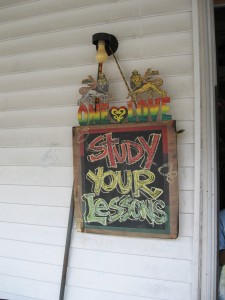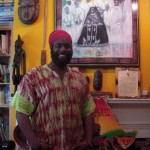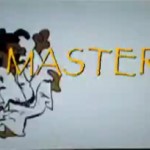A welcome house of another sort is the place where Germantown artist Amir Mark Lyles lives. To call it Lyles’ house is somewhat misleading, since he’s a part of a complex organism, a web of love that includes Lyles’ life partner Naeemah Patterson and their five children, ages 5 to 11. They all live together in a little row house, just two stories, crowded with art and people who somehow live in a peaceable kingdom.
I went there with my friend Joanne for a studio visit, with not a clue of what to expect. A blackboard sign on the front porch, hanging next to the door, stated in colorful chalks, Study your lessons. The five children are home schooled, and part of that day’s lessons included the admonishment to do them! Patterson said she changes the message on the blackboard regularly.
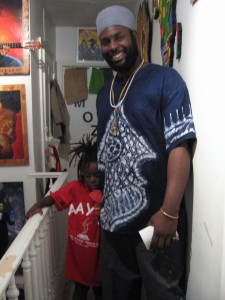
I don’t know how all seven people can live amicably, basically home full time, in so little space filled chock-a-block with art. Well not full time. The kids run out the play when the rest of the neighborhood children come home from school. When I entered the front door, I felt like I had walked into the idealistic 1960s when the personal was political and the political was personal, a time when people talked about making love and not war, a time when rowhouse communes spilled over with large, amorphous families reconfigured to create their own pocket utopias in the city.
But those times had a dark side, when the politics of protest raged, when couples and partnerships could suddenly turn fluid and even dangerous, and when packs of kids pinging off adult jealousies raced around those communes, underfoot and unhappy.
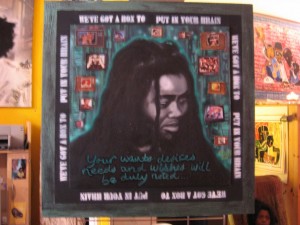
No kids in this Germantown house looked or acted unhappy. The children were busy, active, bright and yet not underfoot. These children clearly know how to think for themselves and be themselves. They don’t need the constant attention of the adults around them. They aren’t numb in front of a TV, partly because the family decided they couldn’t afford the cable bill. But the decision is bigger. Lyles says of the passive experience of sitting in front of the TV, They tell you what to think.
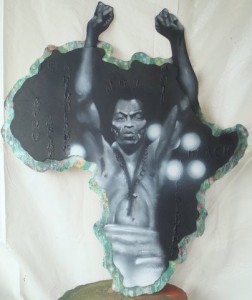
Lyles, 38, caught my full attention when Patterson sent us a notice of a show he was having in Texas. The notice for Africa Create Us, the exhibit in Austin at Diverse Arts gallery, came with a figurative painting of Nigerian Afro-beat artist Fela Kuti (you can find on the internet the photo of Kuti on which this is based), who well before his death had become a cult hero. Lyles painted Fela breaking out beyond the edges of a panel shaped like the map of Africa. I was intrigued–by the mix of surprising and conventional, pop culture and personal thoughts.
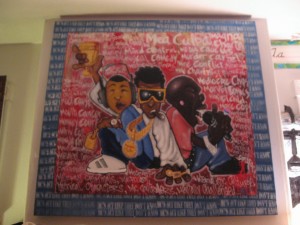
Lyles’ paintings and collages are all about identity, culture, and politics. Some look like they target an African-American audience, but many speak easily to everyone. The distinction is mine, not Lyles’. And all the recent work with music-references, like the music itself, seems to me to be crossover work. All the work reflects his interests. He is inspired by his African roots and he is inspired by music by African American artists. He listens to a lot of hip hop, reggae and jazz. And he is sometimes put off by the messages that lurk in the lyrics and the culture. He trades on pop culture, design, kitsch, formulaic imagery and completely original ideas–whatever it takes to express what’s on his mind. The brew is sometimes indiscriminate, sometimes pretty amazing!
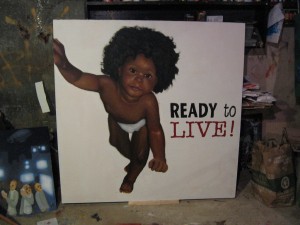
He talks back to Biggy Smalls’ Ready to Die with an alternate lyric. “Why didn’t he say, Ready to live?” asks Lyles, who is disturbed by the negativity of so many hip-hop performers. The paintings alter the original message to reflect his own optimism and outlook.
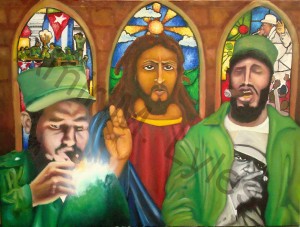
He paints his own interpretations of the lyrics he hears, putting them in the context of his own life. He surrounds a beautiful Tracy Chapman with tiny TVs and borders the painting with her lyric “We’ve got a box to put in your brain.” He paints a satirical cartoon of blinged-out hip hop MC’s, inspired by the lyric “MCs act like they don’t know,” those words stenciled to create a border. He’s not limited by any rules. His MC painting is embellished with rhinestones. And behind the figures are words, lots of them, all beginning with MC, from Mea Culpa and Murder Cartel to Mentally Challenged. He does not approve.
When he sees kids disconnected from what’s around them with headphones on, he’s worries. “I know you’re not listening to books on tape,” he says, quoting his imaginary conversation with them.
I wonder where Lyles grew up. The answer is Harlem, where it wasn’t always pretty. He studied painting in the New York City art magnet schools. He also studied with his older brother, artist Richard Toler.
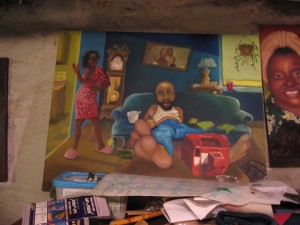
He tried to make it working in the corporate world where he discovered he was supremely unhappy. And he moved to Philadelphia to be with Naeemah. Now he’s home all day painting or taking care of the family. (I wonder how they get by).
We ask about an iconic painting with aerodynamic hair. “You hear this person killed that person. There’s more to us than that. This is somebody’s angel, this is somebody’s baby. To a Rastafarian locks are symbolic–the hair is angel wings.”
I ask about his five kids. He answers, “Angels are all around.” They also have mega hair.
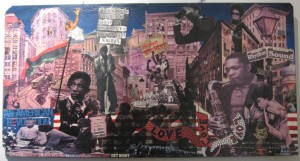
Upstairs in the hallway, Lyles has several collages, honoring Marvin Gaye. Watching for the Next Freedom Train is a complex salute to the civil right movement of the ’60s,with lots of well-thought-out details adding to the depth of the composition.
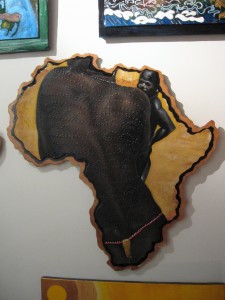
On our visit we discovered other Africa-shaped panels besides the Fela painting. The shaped panels are the basis for a series that covers a variety of subjects about African identity, painted in a variety of styles–an Ethiopian-style icon of Haile Selassie (Lyles mentioned he and his family are Rastafarians); Ndebele Girl, a stylized figure-ground study in which the Ndebele background pattern competes with the subject’s bright outfit, or a realistic mixed media scarified female torso (copied from a National Geographic) that becomes its own sort of map within a map. The scars are bits of leather easily confused for paint in a reversal of the idea of trompe l’oeil.
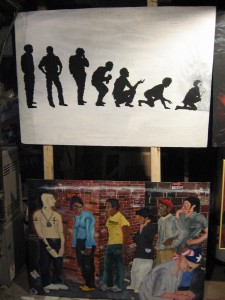
Down in the basement, which doubles as Lyles’ studio, the paintings range from Ash Can School to cartoons. Pop and glib mix with serious and complex. On our way out we notice a mixed media panel–a door–that captures the horror of the Door of No Return through which captive Africans boarded ships taking them from Africa’s west coast to slavery in the New World.
I wonder why an artist in Philadelphia gets a show in Texas but can’t get his best work shown in Philadelphia. Lyles says he’s done trying for a gallery. He’ll find another way. (He’s a little dreamy, but maybe he’ll do it.)
Lyles’ work comes from his heart. He is looking at everything, taking it in and using painting and collage and every kind of imagery he’s ever seen to process it all–the past, the present, the political, the personal, the spiritual world, the real world.


